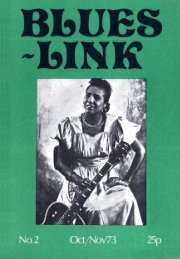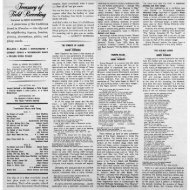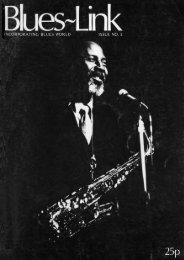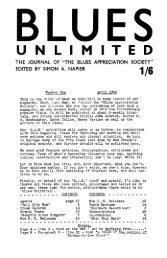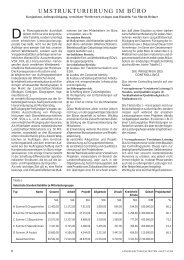The Blues Collection 84: EAST COAST BLUES.- Orbis Publishing ...
The Blues Collection 84: EAST COAST BLUES.- Orbis Publishing ...
The Blues Collection 84: EAST COAST BLUES.- Orbis Publishing ...
Create successful ePaper yourself
Turn your PDF publications into a flip-book with our unique Google optimized e-Paper software.
<strong>EAST</strong> <strong>COAST</strong> <strong>BLUES</strong><br />
CHRONOLOGY<br />
1926 1927 1939 1932 1935 1949 1941 1947<br />
Blind Blake makes his Howard Armstrong Blind Boy Fuller Blind Boy Fuller dies.<br />
first records for and Carl Martin make makes his first Sonny Terry and<br />
Paramount. their first record, as recordings, and Brownie McGhee<br />
members of the becomes the major become a permanent<br />
Tennessee Chocolate influence on the partnership, moving<br />
Drops. hey will sound of East to New York the<br />
record together again<br />
in the 1970s, and<br />
Armstrong will<br />
release a fine CD in<br />
Coast blues following year.<br />
1995, at the<br />
Alec Seward and<br />
age of 86. Josh White begins to Louis Hayes (aka<br />
Victor’s Ralph Peer record blues and Guitar Slim and Jelly<br />
make field folksongs with an Belly) make their first<br />
recordings of North Blind Blake makes his element of social records in New York,<br />
Carolinian Julius last recordings, and protest, in contrast to but i an<br />
Daniels, and Virginia’s disappears from his earlier straight old-fashioned,<br />
Luke Jordan. the scene. blues recordings. acoustic style.<br />
opportunities to play according to his<br />
own tastes rather than that of the market.<br />
Or take the guitar and harmonica<br />
team of B obbie Leecan and R obert<br />
Cooksey, a hot act in the black sections<br />
of New York and Philadelphia in<br />
th e 1920s. <strong>The</strong>y d utifully m et th e<br />
relen tless demand for blues with a<br />
stream of elegant 12-bar instrumentals.<br />
It was only when they were let loose in<br />
a jazz band or skiffle setting that they<br />
showed what sparkling and technically<br />
demanding music they could produce.<br />
Some artists escaped the blues noose,<br />
like the enchanting guitarist William<br />
Moore, a barber with the melodious<br />
address of Tappahannock on the river<br />
Rappahannock, in the Tidewater area<br />
of East Virginia. At a single session in<br />
1928 he recorded a beguiling set of rag<br />
songs, such as ‘Ragtime M illionaire’<br />
and ‘Tillie Lee’, interspersed with lilting<br />
guitar set-pieces, like ‘Old Country<br />
R ock’ and ‘B arb ersh o p Rag’. ‘Only<br />
1002<br />
barber in the world can shave you and<br />
give you music while h e’s doing it,’<br />
comments a bystander.<br />
B e l a t ed r ec o g n it io n<br />
Virginia could claim to be a lost world<br />
of the blues. Moore and Jordan’s successors<br />
include singer-guitarists Carl<br />
Martin (born 1906), Archie Edwards<br />
(born 1918), Pernell Charity (1920-79),<br />
John Tinsley (born 1920), Carl Hodges<br />
(born about 1933) and Turner and<br />
Marvin Foddrell (born 1920s), all of<br />
whom secured places for their elegant<br />
music on LPs in the 1960s and 1970s.<br />
Martin, alone among these, had previously<br />
recorded, in the 1930s while<br />
living in Chicago. Also recorded in that<br />
decade (in the deadly Depression year<br />
of 1933) was Lynchburg’s Spark Plug<br />
Smith, a jolly-looking singer and guitarist<br />
with a high, wavering voice not<br />
unlike Luke Jordan’s, who varied his<br />
blues with such left-field material as<br />
the pop songs ‘My Blue Heaven’ and ‘A<br />
Shanty in Old Shanty Town’.<br />
Alec Seward (1901-72) left his birthplace,<br />
the naval port of Newport News,<br />
during the mid-1920s to live in New<br />
York, a journey that would be repeated<br />
ABOVE LEFT: During the 1920s the father and son<br />
team Andrew and Jim Baxter recorded both blues<br />
and traditional white tunes.<br />
OPPOSITE: Harp player Phil Wiggins teamed up<br />
with John Cephas in the late 1970s. During the<br />
next two decades they toured all the continents.







